Emil Wolff's Thetis, myth according to the beauty and measure of neoclassicism
In 1828, a then 26-year-old Emil Wolff (Berlin, 1802 - Rome, 1879) set off for Malta and Greece on a journey that would last nine months.Wolff was already a talented artist, but he wanted more. He wanted to know everything aboutancient art, and he thought that a complete education could not be called such without having visited the places where it was possible to admire classical statuary in its context. That experience turned out to be fundamental for him, because it contributed to making him one of the most knowledgeable artists of antiquity on the Roman scene.Wolff, in fact, had moved to Rome as early as 1822, and would never leave the Eternal City again (the scholar Dietmar Vogel called him a “German-Roman”), becoming moreover one of its most well-known and established artists, to the point of being appointed, in 1874, president of the most important Roman artistic association, theAccademia di San Luca.
Among the earliest works most marked by this very vivid interest in Greek culture increased partly through the trip to Greece is a sculpture that Emil Wolff first mentions in 1832, in a letter sent on March 10 of that year to the other great German sculptor of the time, Christian Daniel Rauch (Bad Arolsen, 1777 Dresden, 1857). The younger artist had begun work on a work whose protagonist was the nymph Thetis, mythological mother of the hero Achilles. Thetis was a beautiful Nereid, a sea nymph, and she always tried to protect her son from the pitfalls of the Trojan War where she knew, due to a prophecy of the soothsayer Chalcis, that he would lose his life: first by sending him to Syros to the court of King Lycomedes, disguised as a woman so that he would not be called to war, and then, once Odysseus discovered Thetis’ deception and the young man was therefore forced to leave for Troy, by having him forge invincible weapons. His mother’s care was to no avail: Achilles was in fact killed by Paris, who struck him in the heel, the only weak point in his body, which his mother had made invulnerable by immersion in the Styx, the hellish river whose waters were endowed with such miraculous power. Wolff depicts the moment when the mother, riding a dolphin, goes to Troy to bring weapons to Achilles. She is thoughtful and brooding, inwardly processing her grief, for she already foreshadows the future end of her son.
The poor nymph appears utterly disconsolate, though she avoids open displays of mourning: Wolff’s neoclassicism, which looked to the imperturbability and impassivity of the figures of his master Bertel Thorvaldsen (Copenhagen, 1770 - 1844), holds fast to the ideal of “noble simplicity and quiet grandeur” theorized by Winckelmann. Teti’s sadness is thus all communicated by her gaze, her pose, and her gestures: her eyes, thoughtful, are turned downward, and her gaze is almost lost, closed to any comfort. The nymph, her head recumbent, is actually looking at the helmet that Hephaestus forged for Achilles. Although the subject is a deity, it is necessary to note (and in this perhaps Wolff takes a license from his usually over-controlled style) the intense humanity of the gesture of the right hand, with the fingers gently and slowly flowing to caress the surface of the helmet, as if the object might constitute a surrogate for the absent son, whom Thetis will shortly inexorably lose. The same body, listlessly reclining on the dolphin’s back, seems to be traversed by a motion of affliction that pervades all the limbs, with the left arm stretching out to merely hold the sword so that it does not fall into the sea, and the legs that do not maintain a firm and secure position, but almost abandon themselves and with their delicate feet graze the waves of the sea.
 |
| Emil Wolff, Thetis with the Arms of Achilles (c. 1838; marble, 91 x 83 cm; St. Petersburg, Hermitage). Ph. Credit Finestre Sull’Arte |
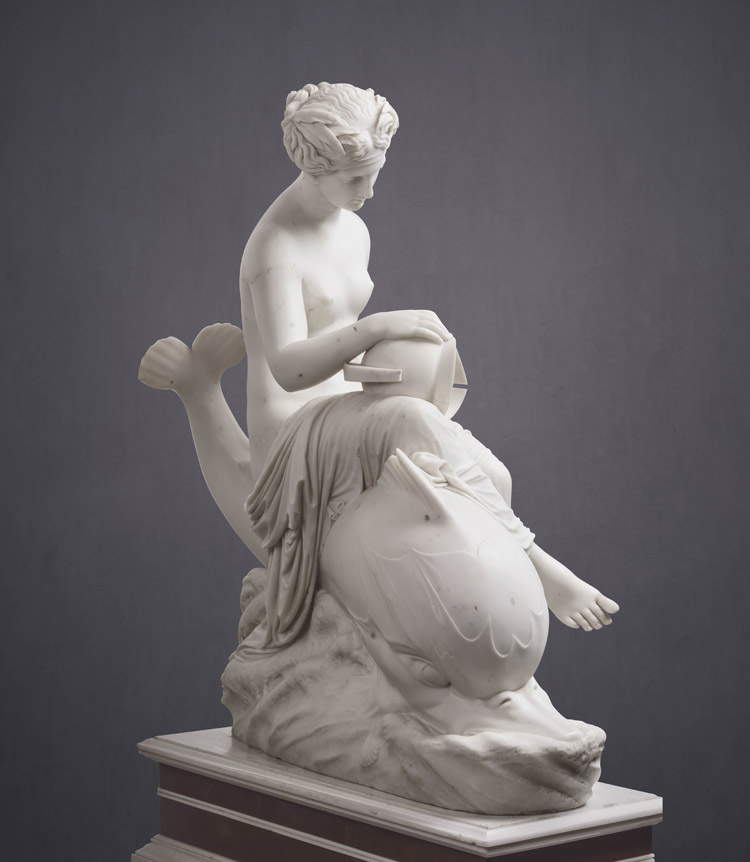 |
| Emil Wolff, Thetis with the arms of Achilles on the back of the dolphin. Ph. Credit Danae Project |
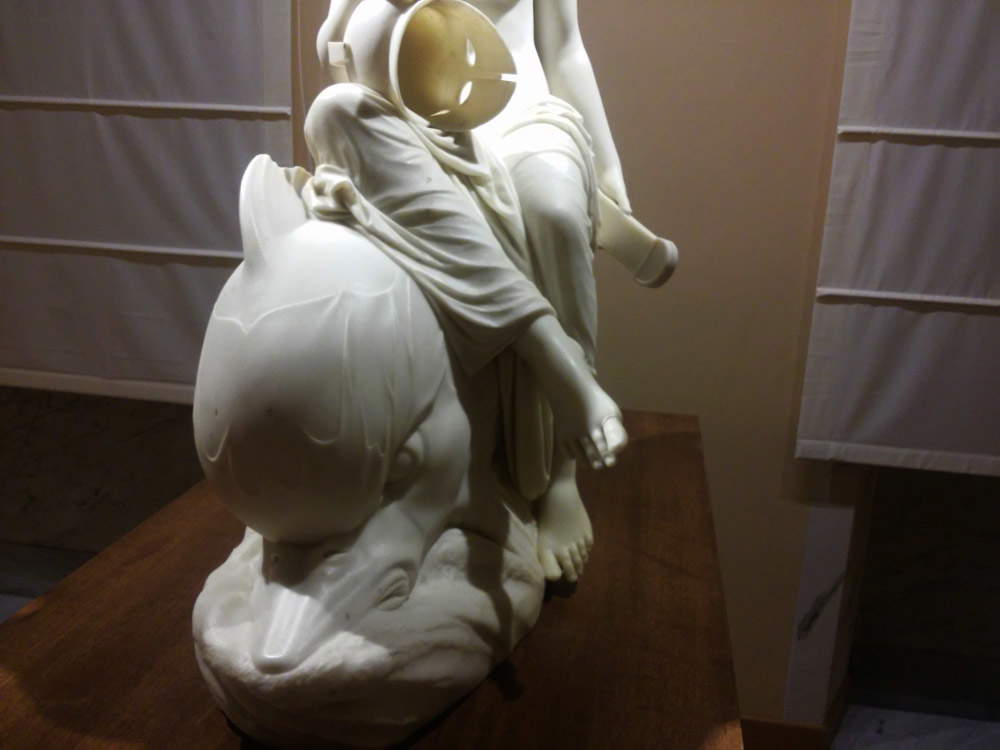 |
| Emil Wolff, Thetis with the weapons of Achilles, detail of the dolphin. Ph. Credit Finestre Sull’Arte |
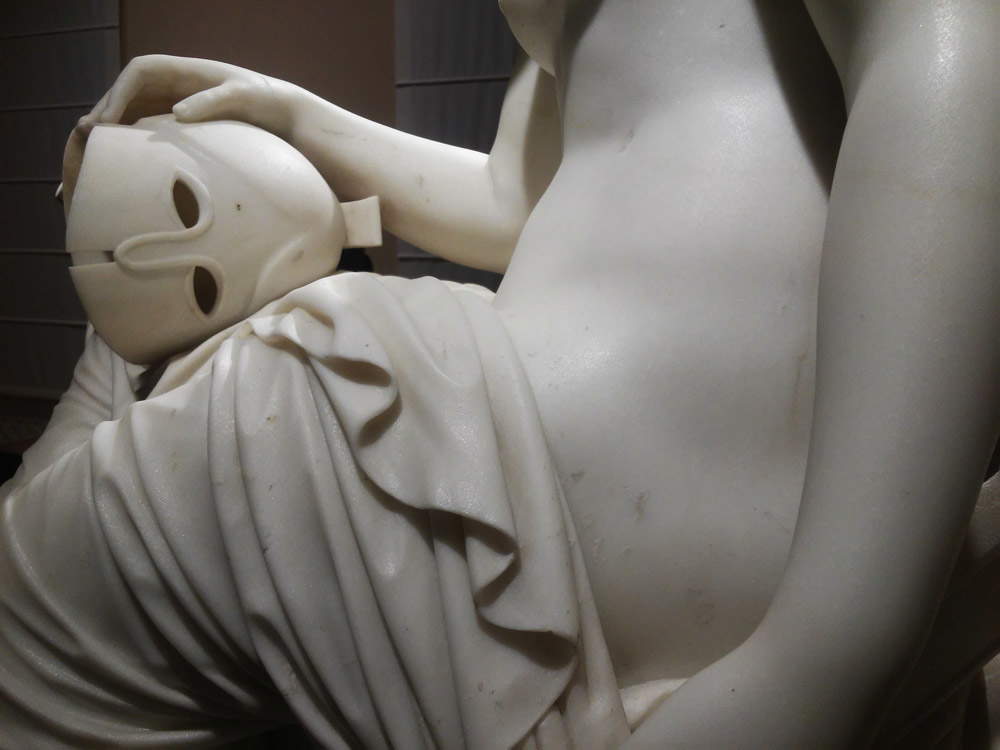 |
| Emil Wolff, Thetis with the weapons of Achilles, detail of the helmet. Ph. Credit Finestre Sull’Arte |
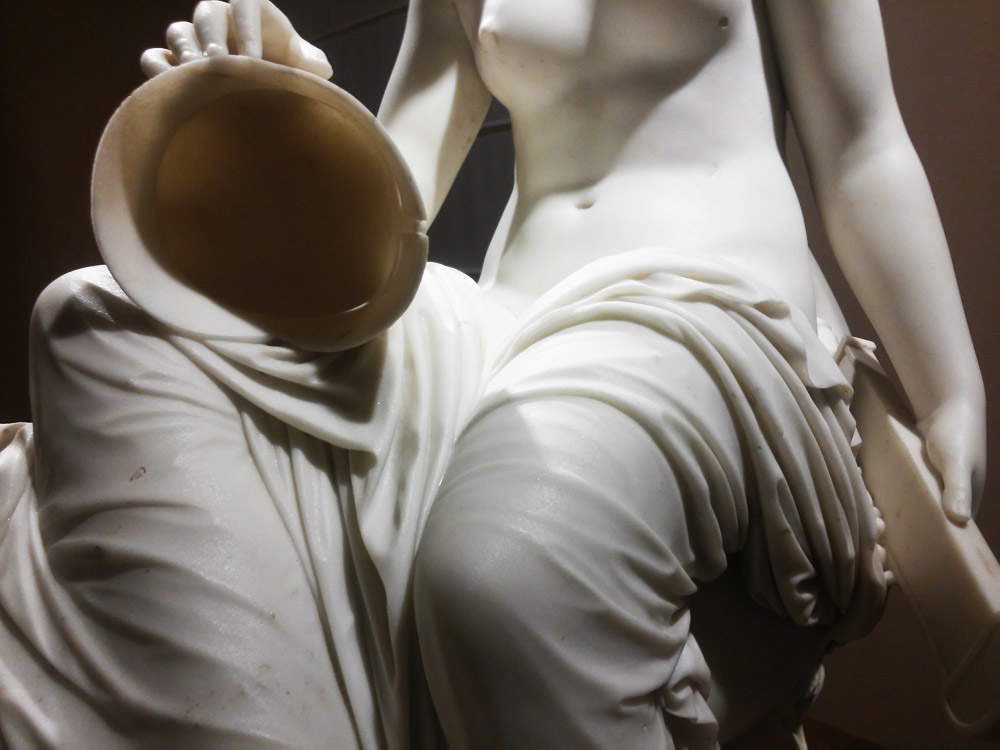 |
| Emil Wolff, Thetis with the weapons of Achilles, detail of legs. Ph. Credit Finestre Sull’Arte |
 |
| Emil Wolff, Thetis with Achilles’ weapons, detail of Achilles’ sword. Ph. Credit Finestre Sull’Arte |
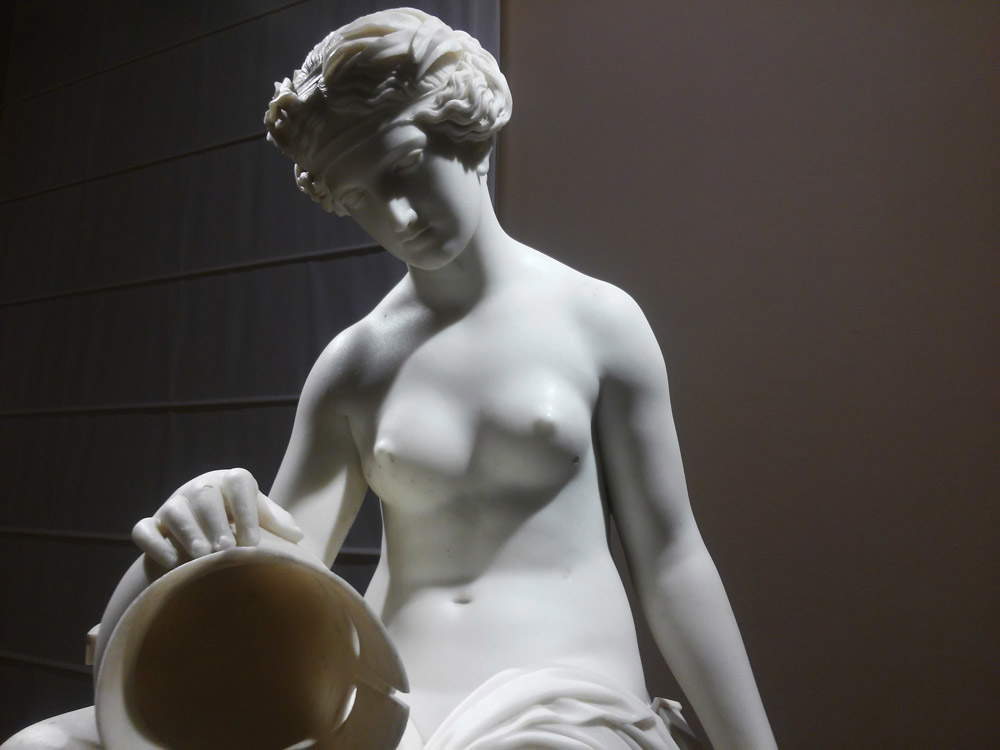 |
| Emil Wolff, Thetis with the weapons of Achilles, detail of the face. Ph. Credit Finestre Sull’Arte |
This sculpture required years of work, and certainly the marble we see today, which Wolff arrived at only in 1838, is quite different from the initial drafting of the work, from his first plaster model. We know that, in the same 1832, the artist presented in Berlin a plaster group in which Thetis was not alone: in fact, the work depicted the nymph in the act of handing Achilles the new weapons forged by Hephaestus so that the young man could avenge the death in combat, at the hands of Hector, of his brotherly friend Patroclus. However, in the following years, the artist substantially modified his sculpture, arriving at the final redaction in which the subject is Thetis alone with the Arms of Achilles.
The Polish diplomat Atanazy RaczyÅ„ski, who was the author of a Geschichte der neuen deutschen Kunst (“History of Modern German Art”), lets us know that “for Countess Wielhorsky, born Princess of Courland, Wolff made a Thetis with the Arms of Achilles sitting on a dolphin.” The commissioner was thus Luise von Biron, one of the daughters of Carl Ernst von Biron, younger brother of Peter, Duke of Courland, a state that had already been annexed to the Russian Empire in 1795. “The motif,” RaczyÅ„ski continues, “derives from a fragment of an ancient statue found in the Vatican’s Belvedere,” and furthermore the source also informs us that, in his studio, the artist kept a replica of the work. The “statue” mentioned by RaczyÅ„ski could be the relief that adorns a sarcophagus preserved today in the Vatican Museum s (in the Museo Pio Clementino to be exact), in which the Nereids appear carrying the arms of Achilles. Looking at the work, which was found in 1789 and can be dated to the mid-2nd century AD, one can see how Wolff seems to have drawn inspiration from the second figure, from the Nereid sitting astride her dolphin with her hand resting on her tail and her knee slightly raised, and even the dolphin itself seems to recall the one we see in the ancient relief, as Elena Karcëva notes in the file on Wolff’s work included in the catalog of the exhibition Dopo Canova. Paths of Sculpture in Florence and Rome (Carrara, Palazzo Cucchiari, July 8 to October 22, 2017), where Thetis with the Arms of Achilles is among the featured works.
The original cited by RaczyÅ„ski, in marble, was first exhibited in 1838, but that work is considered lost. The one we admire today in the halls of theHermitage in St. Petersburg is a replica that figures around 1870 in the collections of Baron Aleksandr Stieglitz. We know this because the sculpture appears in a painting by Luigi Premazzi (Milan, 1814 - Istanbul, 1891) belonging to the cycle of paintings depicting the interiors of the baron’s residence: the Thetis is located in the Drawing Room, above a marble base, opposite the window.
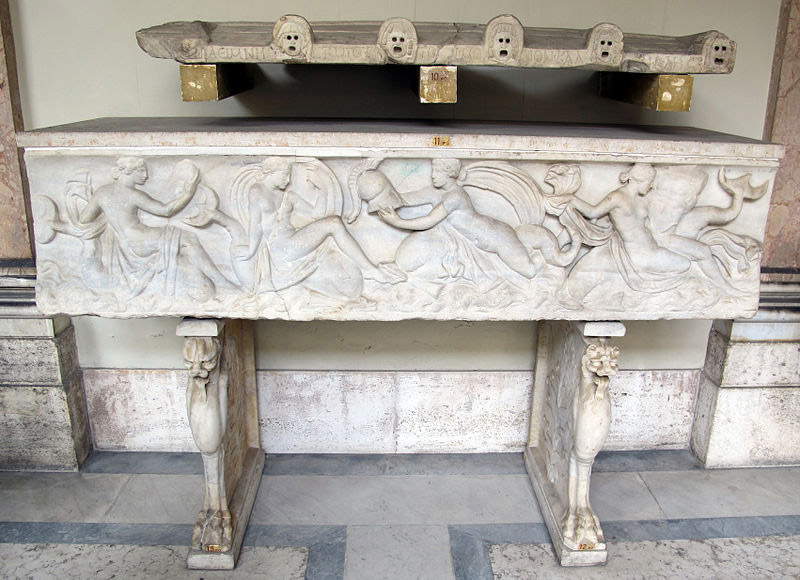 |
| Roman art, Sarcophagus with Nereids bearing the arms of Achilles (140-150 AD; marble, Rome, Vatican Museums, Pio-Clementine Museum). Ph. Credit Francesco Bini |
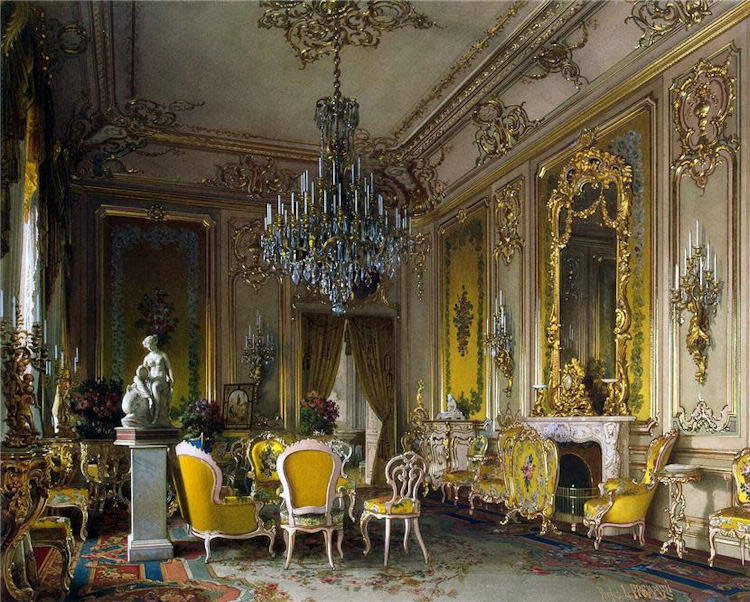 |
| Luigi Premazzi, Residence of Baron Stieglitz. The Drawing Room (ca. 1870; watercolor, 34.5 x 43 cm; St. Petersburg, Hermitage) |
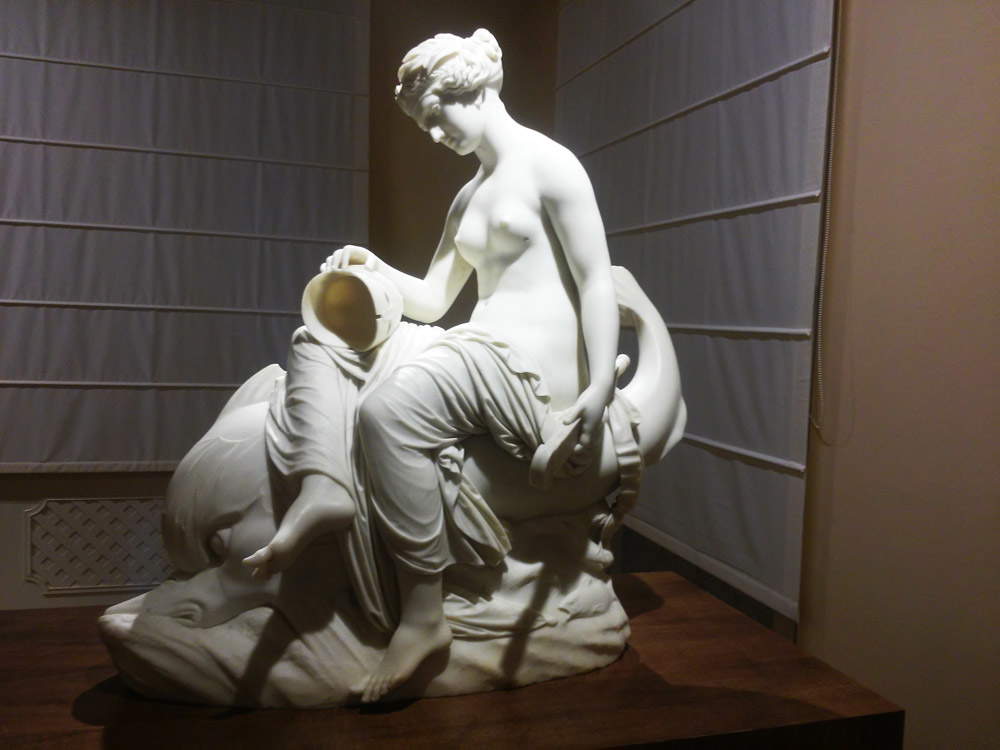 |
| Emil Wolff, Thetis with the arms of Achilles. Ph. Credit Finestre Sull’Arte |
From Baron Stieglitz’s collections it then passed to those of his nephew, Aleksandr Polovtsov, who between 1911 and 1912 gave Thetis to the noblewoman Aleksandra Narykina, in whose palace it appears in the year of the Russian Revolution, 1917. The work, in 1923, was then transferred to theHermitage, where it remains today and where it can be admired as one of the most interesting sculptures produced by the hand of this talented neoclassical artist, German by birth but Roman by adoption.
Reference bibliography
- Sergej Androsov, Massimo Bertozzi, Ettore Spalletti, After Canova. Paths of Sculpture in Florence and Rome, exhibition catalog (Carrara, Palazzo Cucchiari, July 8-October 22, 2017), Fondazione Giorgio Conti, 2017
- Giandomenico Spinola, The Pio-Clementino Museum: The Eastern Sector of the Belvedere, the Octagonal Courtyard and the Animal Room, L’Erma di Bretschneider, 1996
- Dietmar Vogel, Der Deutsch-Römer Emil Wolff (1802-1879). Bildhauer, Antikenrestaurator und Kunstagent, Peter Lang Internationaler Verlag der Wissenschaften, 1995
Warning: the translation into English of the original Italian article was created using automatic tools. We undertake to review all articles, but we do not guarantee the total absence of inaccuracies in the translation due to the program. You can find the original by clicking on the ITA button. If you find any mistake,please contact us.




























